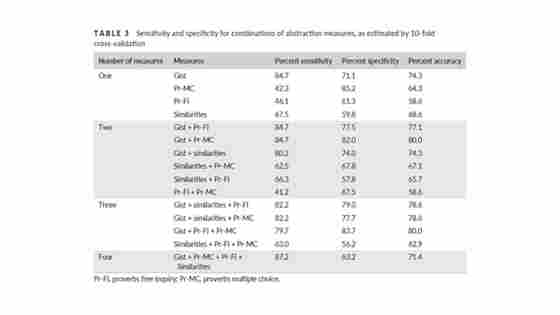Overview
In everyday life, we are required to pull out meanings from large amounts of complex information - gist reasoning. We engage in this process when reading, watching television, having conversations, doctor's appointments, and meetings at work. This ability has been consistently shown to be impaired following a traumatic brain injury (TBI). This study seeks to expand upon prior publications by further examining the differences in abstraction between injured and uninjured adults. Additionally, this study investigated the sensitivity of popular measures of abstraction in their ability to distinguish injured and uninjured adults as well as which combination of abstraction measures is most sensitive and specific.
Table 3. Sensitivity and specificity for combinations of abstraction measures, as estimated by 10-fold cross-validation. 10-fold cross-validation analyses demonstrated gist reasoning performance to be the most sensitive (84.7%) as compared to performance on proverbs (free-inquiry 46.1%, multiple-choice 42.3%) and similarities (67.5%) in identifying abstraction deficits in TBI population versus healthy adults (Table 3). Results also indicated proverbs multiple-choice format to have the highest specificity (85.2%) followed by gist reasoning (71.1%), proverbs free-inquiry format (61.3%), and similarities (59.8%). Combinations of measures did not yield significant gains in sensitivity and specificity than found on a single measure (i.e., gist reasoning for sensitivity and proverbs multiple choice for specificity) (Table 3). However, gist reasoning and proverbs multiple choice together yielded the highest combination of sensitivity and specificity, 84.7% and 82%, respectively.




